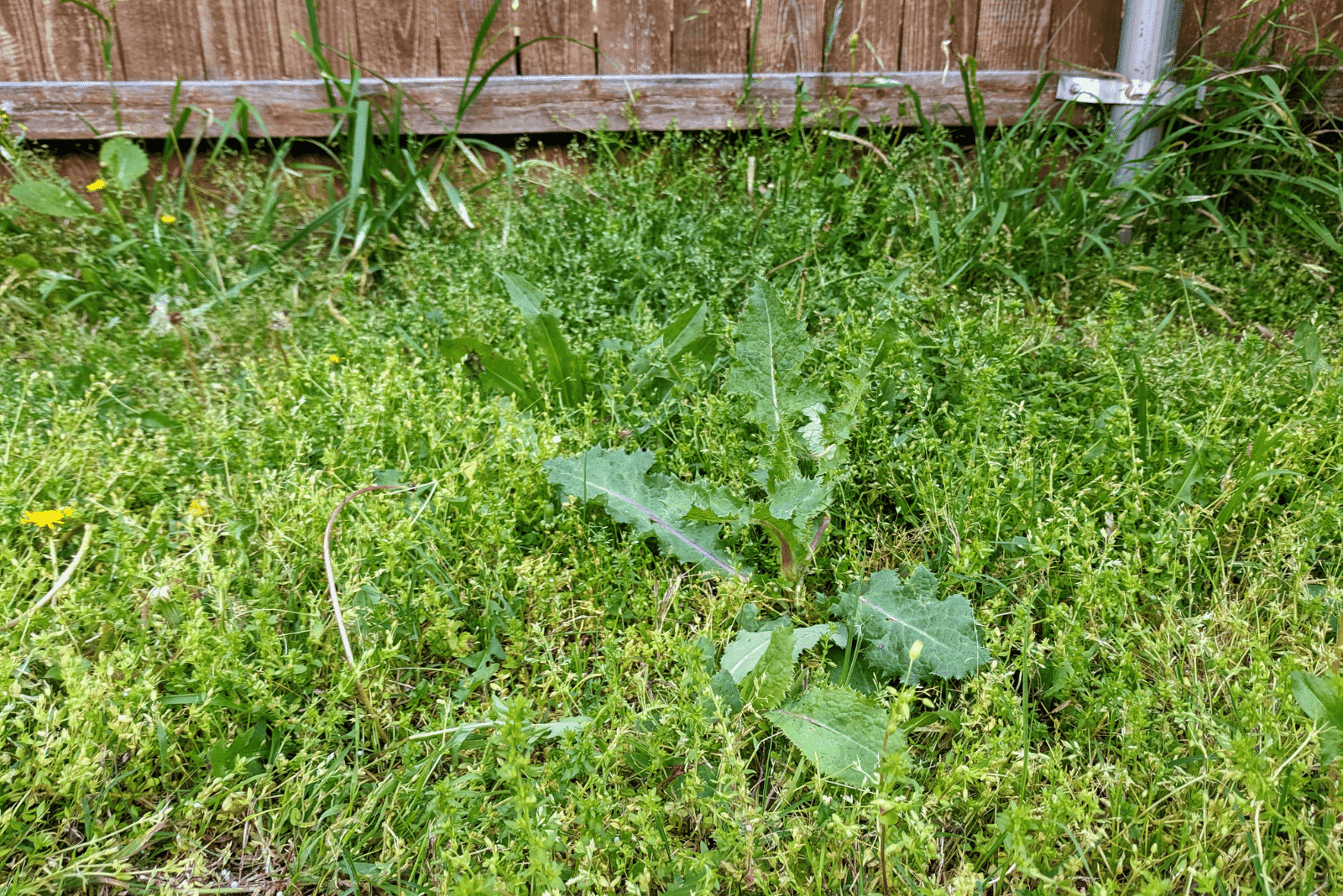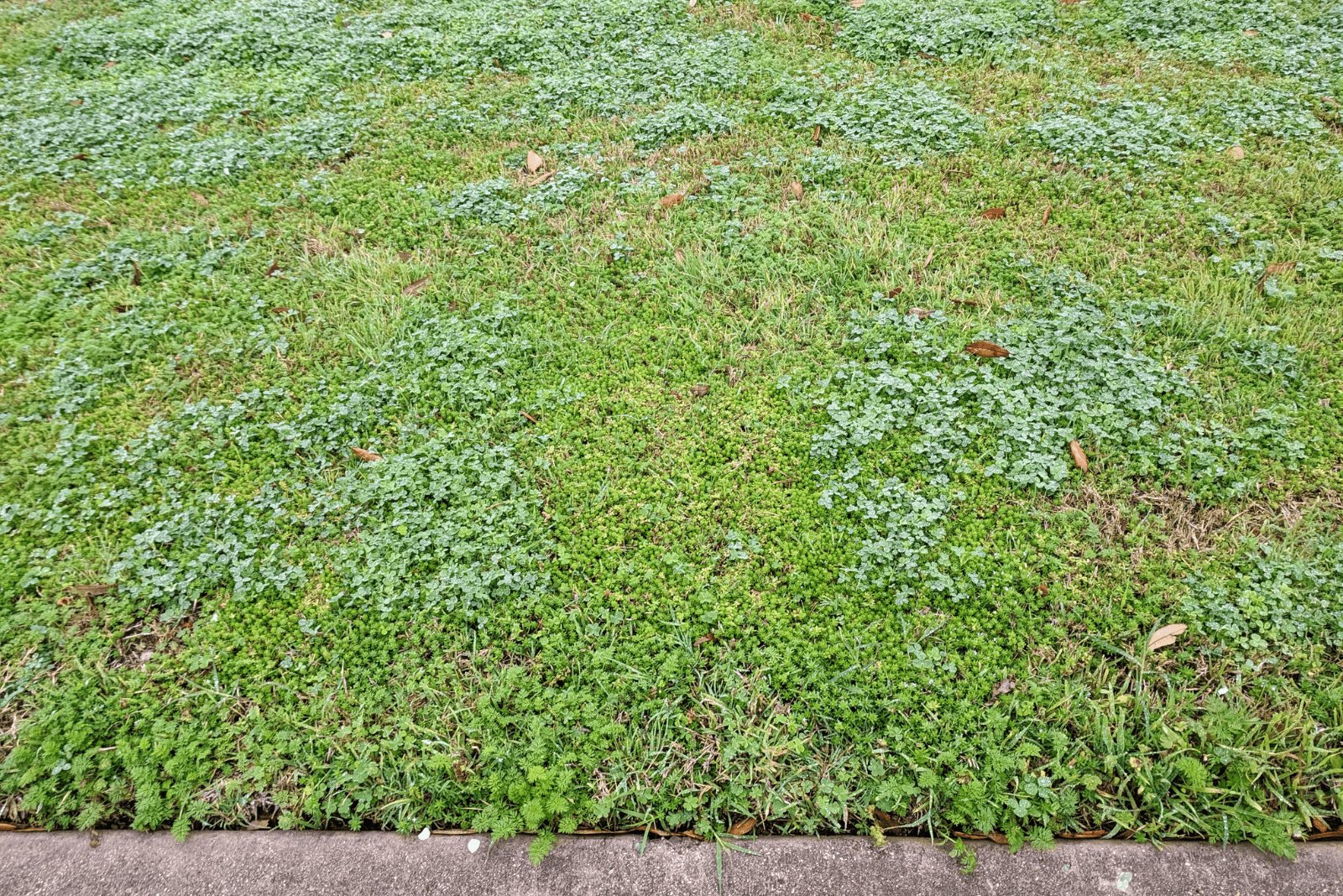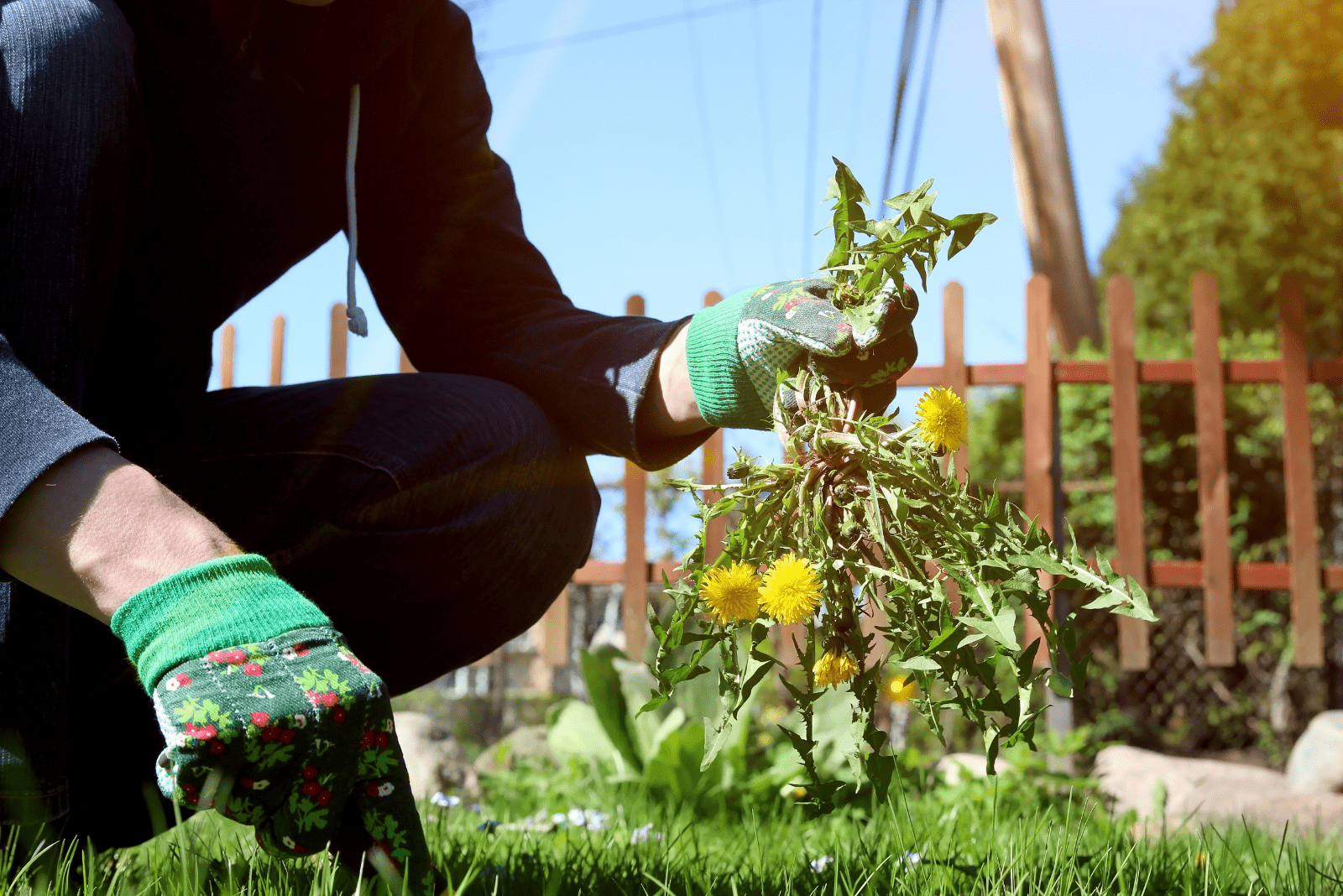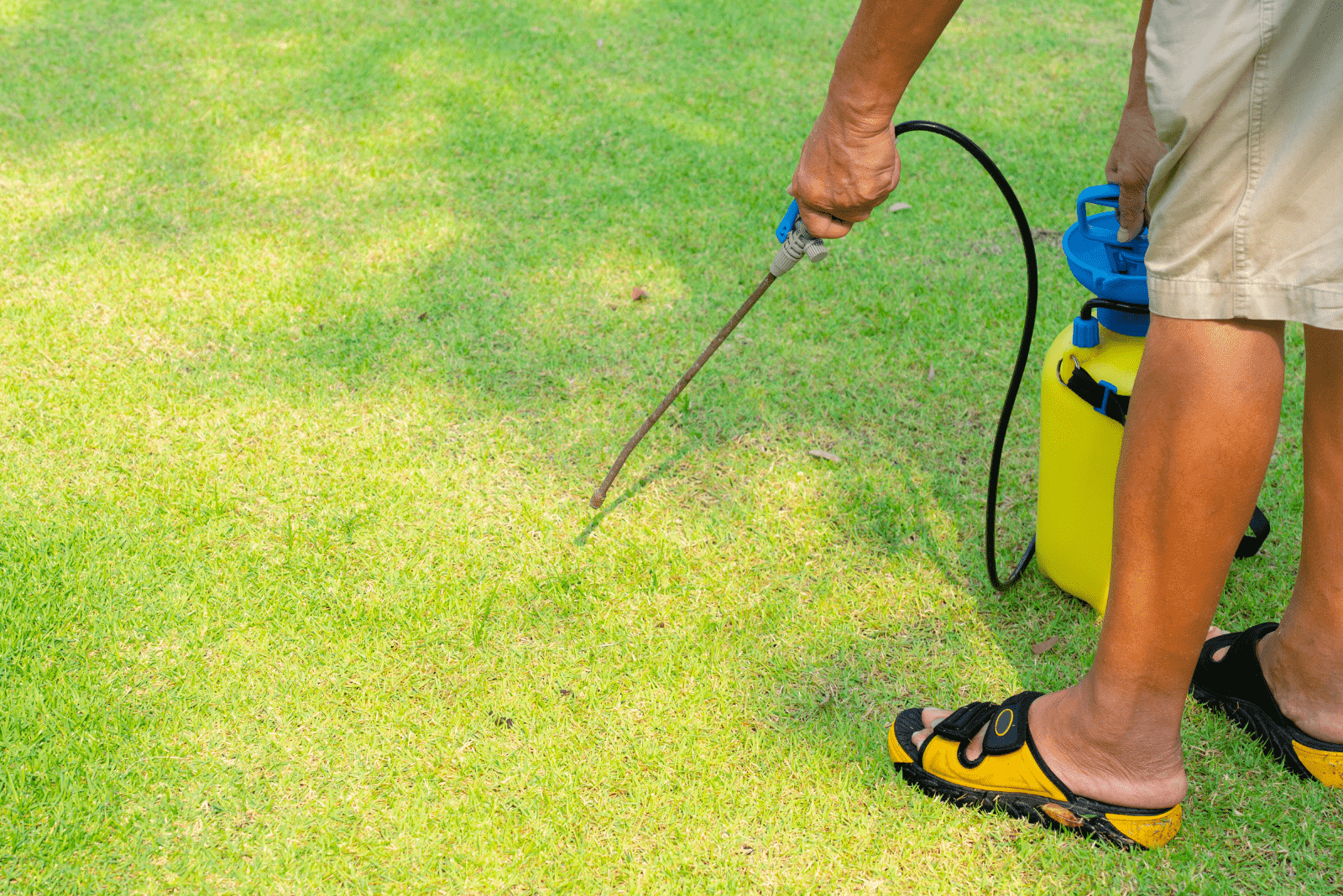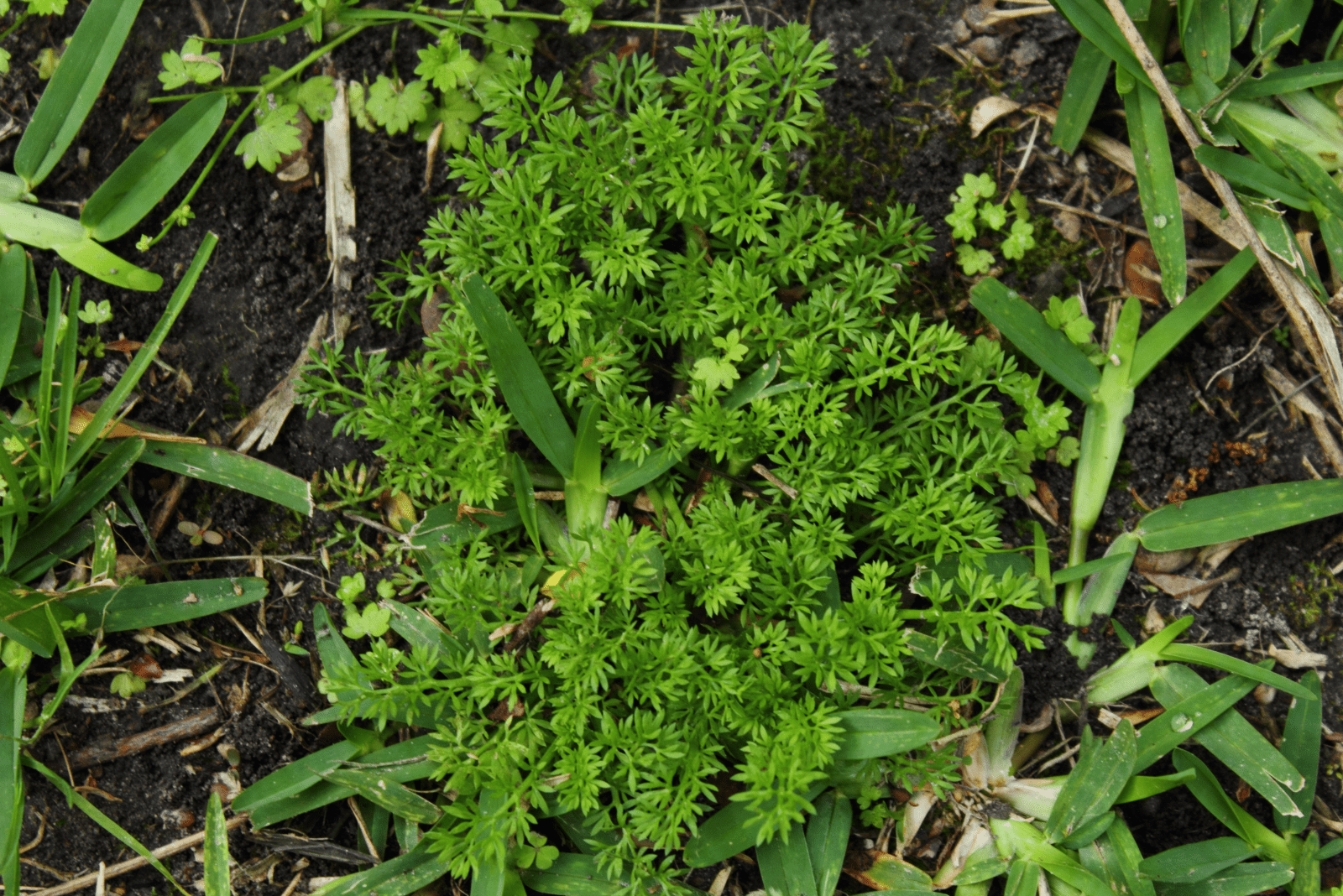All pet owners know how annoying stickers can be, especially if they are all over your lawn!
Grass stickers, grass burrs, pricking monsters, burweed, field sandbur sticker plants, sticker burrs, caltrop, yellow vine, sticker burrs, puncture vine, goat head, and burweed stickers… these are just some of the names of stickers, though they could all collectively be called annoyances!
Not only do they get tangled in hair and are impossible to get out, but they can also hurt your feet when walking barefoot on your own lawn — and don’t get me started on the chaos they cause to your plants!
Read on to discover some of the different types of stickers in grass, as well as how to get rid of them.
What Are Stickers In Grass?
First, let’s define what these stickers in the grass actually are.
Lawn burweed, also known as Soliva sessilis, is an annual weed that germinates during the early fall and winter seasons when temperatures are cooler. They remain unnoticed during these months, however, the real trouble comes once the temperatures start rising.
They start to rapidly grow leaves that are approximately half to one inch long and about half an inch wide. These lawn weeds also produce flowers in the spring, which have a delicate yellow color and will later turn into one of your worst nightmares!
These flowers produce seeds, and once the burweed starts to deteriorate and die, these little seeds become sticky. All of the trouble starts when they spread all over your lawn because there are a lot of them and they clump together to form a sticker.
Once you find stickers on your lawn, the damage is done. There is no type of weed control that can kill these little annoyances; the solution lies in preventative measures.
You must first be able to identify the burweed in order to get rid of it, so let’s take a look at some of the common sticker weeds.
Identifying Different Types Of Sticker Weeds
Whether we are dealing with grass burs, burweed, or broadleaf weeds, they are all referred to as sticker weeds.
Almost every homeowner will have dealt with this issue, especially if they are in a dry and warm climate. Sometimes it can be hard to maintain a healthy lawn because of weeds constantly growing.
They are commonly found in Bermuda grass types, though they can also be found in some other grass types like St. Augustine. Regardless of the type of grass, they like to grow on lawns and turf grass with moist soil.
We are going to show you the distinctive features of several different types of sticker weeds to help you identify them on your lawn and eventually remove the little devils!
1. Yellow Vine Stickers
If you notice little yellow stickers all over your garden or lawn, you are probably dealing with yellow vine stickers. These seed pods are round, have four sharp points on them, and kind of look like a toy for pets.
However, you should keep your pets far away from them because they are not toys and will definitely get tangled up in your pet’s hair.
These plants produce bright green leaves with slightly reddish edges, and their green stems turn brown once the plant matures.
2. Burweed
Sticker weeds are annual plants that produce small green leaves and yellow flowers. Once the flowers bloom, they will start producing seeds.
Burweed produces rather large seed pods – around the size of a golf ball, and they have three to five sharp pins. Once the plant starts to die the stem will turn from light green to brown.
This is your cue to immediately get rid of this plant before the stickers spread all over your garden!
3. Lawn Burs
As the name suggests, these types of stickers are specifically found on lawns. They produce seeds that are smaller than burweed seed pods — they are the size of a kernel of corn (don’t mind their size, the smaller ones tangle the most and are the hardest to get rid of!).
These small stickers have four pointed pins on them, which help them adhere to your clothing and hair.
The plant produces light green leaves and stems with white hairs all over — this should help you identify them.
4. Field Sandburs Sticker
Field Sandburs stickers also have smaller seed pods. They are usually the size of an eraser and have a few pointy pins growing on them.
These plants produce green leaves and green stems with fine hairs all over. They are easily recognizable, though they usually grow in fields where there is no grass.
However, these stickers can easily spread so you should apply weed killer to maintain a healthy lawn!
5. Burr Stickers
Burr stickers are probably the most numerous, and can be found anywhere from fields and pastures to different types of lawns and gardens.
These stickers are brown, have lots of spikes, and are much longer than they are wide. The edges of this sticker are more round than sharp and they have a somewhat irregular shape.
The plant produces light green to yellow leaves with a stem that turns brown when the plant is about to die.
6. Grass Stickers
These grass stickers are found in grass types that are usually grown for lawns or gardens. With a pointy end that makes them difficult to notice when growing closely together, they resemble small blades of grass.
When the plant is young, the leaves of this sticker weed are green, but as they get older they turn brown.
If you are growing Bermuda grass on your lawn, I would recommend you read more about weed killers for Bermuda grass — especially if you are dealing with these annoying stickers!
How To Get Rid Of Stickers
We have already mentioned that there is no way to get rid of stickers on your lawn once you notice them.
However, you can always pluck them out one by one instead of applying herbicide to stop their growth.
Let’s look at some other methods that you can use to get rid of stickers.
1. Pulling Weeds By Hand
If you notice that burweed has started growing but hasn’t yet spread all over your lawn, then you can simply pull the entire plant out of the ground.
Hold the weed at the center and then quickly pull the entire plant out with all of its roots. I would suggest you use gloves for protection because the spikes on stickers can be painful!
This can be done at any point during the day, though it’s best to do it early in the morning when the soil is still moist so you can pull the plant more easily.
2. Pick The Stickers Out By Hand
If these little annoyances have started to spread all over your lawn or garden, the only way to get rid of them is by picking them by hand. I know that this can be tiring, especially because it is both energy and time-consuming.
You can also use a rake to gather stickers and pick them from one place, though you might miss some!
Where there’s smoke, there’s fire — and this applies to stickers because if you find any stickers then there must also be burweeds nearby!
Carefully search the area for weeds, and remove them immediately to prevent further spreading if you find any.
3. Use Gardening Equipment
Pulling these weeds by hand can be tiring. Another way to get rid of them is by using gardening equipment. Some of the equipment is necessary for standard lawn care, such as a lawnmower, while others can be rented, like an aerating machine.
You can always use a gardening tool such as a hoe to assist with pulling this entire plant from the ground, though the most effective way is doing it with your hands.
4. Cutting The Grass
We already mentioned that you can use gardening equipment to get rid of these annoying weeds — however, we will go more into detail about cutting grass because there are some specific procedures that you should follow.
Mowing the lawn is a crucial step in lawn maintenance, and when you are cutting the grass you will also be cutting these annoyances. The trick is to cut the grass really low so that you hit the low-growing weeds.
The blades of your mower should be sharp and you should also put a bag on your lawnmower to prevent spreading the stickers.
If you notice burweed growing on your lawn, I would suggest you cut it at least three times a week with a bag attachment. Remember, it’s important to cut weeds before they develop those big seed pods that spread all over your yard.
5. Use Herbicides Or Other Chemical Methods
The quickest way to get rid of weeds is by using weed killers and chemicals. Nowadays they are safe to use and so many options are available!
Herbicides are chemicals used to control or modify unwanted vegetation. The most frequent use of herbicides is in row-crop farming, where they are sprayed either prior to or during planting in order to reduce other vegetation and increase crop productivity.
Herbicides can be classified as either pre-emergent herbicides or post-emergent herbicides.des.
Pre-emergent Herbicide
Pre-emergent herbicides, as their names suggest, take a proactive approach to weed control by working to eliminate weeds before you notice them. Pre-emergents aid in inhibiting germination – the process by which weeds grow and sprout from the soil, as opposed to interfering with the growth process.
Therefore, your already established plants and grass will be safe because this type of weed control only interferes with the infant root system.
Pre-emergent herbicides will get rid of weeds, and stickers won’t have a chance to stick and spread all over the lawn; however, this method takes time and money, and there are a few factors you have to take into consideration, such as the climate in your area.
Some of the most effective pre-emergent herbicides include Benefin and Oryzalin. The best example would be a Roundup herbicide because of its versatility in getting rid of the different types of stickers in grass.
Some of these herbicides are also effective for dandelions and crabgrass, so applying them will leave your lawn in the best condition possible.
Pro Tip: Do not use a pre-emergent pendimethalin herbicide unless the ground has fully thawed.
Whichever herbicide you choose, I strongly recommend following the instructions displayed on the packaging.
Post-emergent Herbicide
Post-emergent weed control methods effectively eliminate many different weed species, including perennial, annual broadleaf, and even grassy weeds (weeds that resemble grass). Post-emergents can be used to spot-treat weeds rather than having to treat entire grass areas, unlike pre-emergents.
The most effective post-emergent herbicide is MSMA (Monosodium methanearsonate).
MSMA is an organic arsenical pesticide now approved for use in the United States. A broad spectrum herbicide, MSMA is used to manage weeds with broad leaves and grasses.
That being said, it can be used to treat these tiring sticker-makers.
Though it’s not always recommended to apply herbicides because it isn’t eco-friendly, gardeners use it because it’s one of the best methods for removing weeds without damaging other plants in the garden.
MSMA should be applied between May and July, so throughout the spring and summer.
However, MSMA is not the only post-emergent herbicide that can be applied when dealing with burweed.
Check out the table below for more information:
[table id=212 /]
S = Safe at labeled rates
I = Intermediate safety, use at reduced rates
NR = Not registered for use on and/or damages this turfgrass
D = Fully dormant turf only. However, during the warmer winter weather of recent years, bermudagrass lawns have not gone fully dormant in South Carolina.
6. Use Organic Methods
There are plenty of gardeners that don’t want to use any pesticides or herbicides, and they always go organic — even with fertilization; they use homemade organic compost to give their plants food.
Luckily there are some organic methods for getting rid of burweed, including:
White Vinegar
Vinegar is often used as an organic weed killer. It’s proven that the acids in vinegar prevent further growth and development of bothersome weeds.
White vinegar contains acidic components toxic to various stickers that grow on grass, and can prevent them from spreading all over lawns.
So, how do you apply it?
Just follow these instructions:
1. If necessary, spray the vinegar directly on the weeds every day until they are gone.
2. Although white vinegar is entirely natural, it should be noted that it can harm grass. The idea is for you to use your spray gun to be more accurate.
3. For each gallon of vinegar, 2 ounces of orange oil should be added to improve effectiveness.
Salt To The Roots
Salt (sodium chloride) kills weeds by drying them out and interfering with their internal water balance. Salt is water-soluble, so it is sprayed most successfully when combined with water as it makes it easier for weeds to absorb.
Salt and water are mixed together to act as a perfect organic herbicide. This solution should be applied to the established roots of weeds to completely dry them out.
You should create a weaker mixture of salt and water (such as 1:2) when you are only applying it to a limited area. If you are applying it to an area where soil health is not an issue, then you can make a much stronger mixture – just add more salt!
Boiling Water
Boiling water is regularly used as an organic method of weed control because the heat causes the plant cells to collapse, disturbing the plant’s structure and sending it into shock. When dealing with young plants, the second application is usually enough to completely destroy the plant.
However, with more mature and established plants you will have to retreat it 7-10 times.
The application is pretty straightforward — all you have to do is boil some water and pour it on the plant that you want gone. Burweed? More like byeweed!
Neem Oil
Neem oil is without a doubt the most widely used organic pesticide and herbicide. It is produced from Azadirachta indica tree seeds. Neem oil contains a substance called azadirachtin, which functions as a natural pesticide and miticide by eradicating unpleasant pests and insects that harm your plants.
Neem oil is also a great substitute for olive oil when cleaning plant leaves.
When it comes to using neem oil as weed control, it is often mixed with half a teaspoon of organic liquid soap — this mixture disrupts the normal functioning of hormones in the plants, which eventually leads to their death.
Flame Weeding
Flame weeding is just a fancy word of saying “burn your plants”. This is a process which involves passing a flame over a weed to kill the plant tissue. The intention is to damage plant tissue rather than completely burn the weed to kill it.
Flame weeding destroys the weed’s surface but leaves the roots unharmed.
However, I wouldn’t recommend this method because you can easily harm yourself and other plants in the garden. It’s also not as effective as other methods because you don’t get rid of the roots, so the weed can easily grow back.
Frequently Asked Questions
1. What are the stickers in grass called?
Grass stickers, grass burrs, pricking monsters, burweed, field sandbur sticker plants, sticker burrs, caltrop, yellow vine, sticker burrs, puncture vine, goat head, burweed stickers,… these are just some of the names of stickers, though they are collectively called sticker weeds!
2. What does it mean if the stickers in my yard are yellow?
If you notice yellow stickers all over your yard, it means that you are dealing with yellow vine stickers. These plants produce bright green leaves with slightly reddish edges, and their green stems also turn brown once the plant matures and gets older.
The stickers produced are yellow and they have four spikes on their surface that can get tangled almost anywhere!
3. What can you do to get rid of stickers in the yard?
There are a few options to choose from. First, you can either pull the entire plant out of the ground or use some gardening equipment to assist you. These stickers are usually picked by hand as there is no other way to get rid of them, however, the trick is to get rid of the plant producing them!
You can do that by constantly mowing your lawn and preventing these plants from growing and producing seed pods, or you can use some type of pre-emergent herbicide or post-emergent herbicide to deal with them much quicker and more effectively.
You can always go organic and use a natural weed killer such as white vinegar, which has similar effects as herbicides. You can also apply salts to the roots of the plant that you want to get rid of.
Conclusion
It seems like there are millions of types of stickers in grass once they start invading your lawn or fields. However, they are all similar in structure and function, so you can use similar methods to get rid of them.
Stickers are a nightmare, especially if you have pets that love to roll on the grass — untangling these stickers is almost impossible!
Luckily, there are a few methods you can use to get rid of these annoyances. Whether you are using herbicide or you’ve decided to go organic and use white vinegar instead, the most important thing is to stay consistent and follow the instructions on the packaging.
You won’t lose this battle, I believe in you!
Best of luck!
Like this post? Share or pin it for later!

